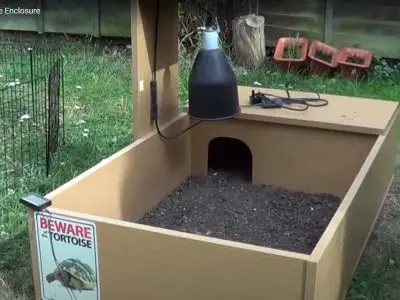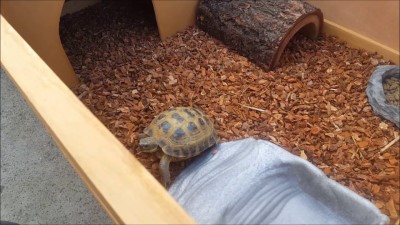How often should you clean a tarantula cage, you ask? It depends on if you are talking about the substrate or the enclosure itself. Different experts will give opposing answers. Let’s look at both and the reasons to clean them.
The substrate is the material in the bottom of the enclosure where the tarantula lives. The substrate can stay in the enclosure indefinitely. Some owners claim they haven’t changed the substrate in years.
Some even say not to change it at all. But for the enclosure, you must clean it more frequently. It depends on your species of tarantula and how it impacts you.

How Often Should You Clean a Tarantula Cage?
The enclosure is the only place your tarantula feels safe. During the daytime, your tarantula usually hides in a comfy burrow or hiding place you have set up for it.
Most tarantulas spray their waste near the opening of their home. The reason for this is so they don’t have to be exposed to predators. So cleaning during the daytime is a sensible idea.
Most tarantulas are spotless and tidy. They like their environment free of debris. The exception to this is their waste. And, they don’t care about the waste on the walls of their enclosure either. It doesn’t seem to phase them.
The one usually bothered by the white waste on the walls is you, the owner. Tarantula waste is a white, milky appearing substance.
It can build up on the walls and make it difficult for you to observe your tarantula. Your tarantula wants to be disturbed as little as possible. So, how often you clean a tarantula cage is up to the owner.
Never clean your pet’s enclosure by placing your hand into the cage. The tarantula may bite you and then you both would be stressed. If you are cleaning the walls of the enclosure, it is recommended you use long tongs to clean it.
Tarantulas not only leave waste behind, but they can leave food boluses, uneaten prey, molts and carcasses.
If you keep on top of cleaning up these things regularly, your substrate and your tarantula will remain healthy. Use the tongs to pick these things up out of the cage.
How Do You Clean a Tarantula Cage?
Again, you will want to use the long tongs. Dampen a cloth or paper towel and, using the tongs, rub away as much of the waste from the sides of the enclosure as you can.
Never spray water into the enclosure as too much water can lead to mold. You should only use warm water only. Never use soap or any chemical cleaners in the enclosure. And be sure not to spray your tarantula either.
For hardened waste difficult to remove, some owners use a moistened cotton swab with the tongs. This will allow you to push a little harder on a specific spot to get the problematic waste off the enclosure walls.
Remember to keep up with this weekly as waste left for an extended time can be impossible to remove as well as cause the enclosure to stink. Decomposing carcasses or uneaten prey can also cause this. As a rule of thumb, clean the enclosure weekly. This will keep mites and bacteria out of the enclosure.
Your tarantula is susceptible to these bacteria and mites as well as mold. They can even kill your animal. You should also remove any areas of mold that you observe. Mushrooms and furry white stuff in the enclosure is one way to distinguish mold.
If you notice waste or food boluses in your tarantula’s water, you should remove the water and dump it out. You need to clean the water dish too. Then replace the water dish with fresh water and put it back in the enclosure.
What About the Substrate?
As previously stated, many owners never change the substrate. But there are a few reasons to change it.
- If you notice mold throughout the substrate, not merely in a limited part of the substrate
- When you are moving the tarantula to a different or larger enclosure
- If the substrate smells musty, has mites, bacteria or the smell of decomposition
Tarantulas get stressed easily and stress isn’t healthy for the tarantula. So changing the substrate as little as possible is the best way to keep your tarantula from being stressed.
There are owners who change out the substrate monthly, but you don’t need to do that unless you have any of the reasons above. The tarantula requires as little maintenance as possible to have a healthy pet.
If you have decorative items in the enclosure like cork or fake plants, it isn’t necessary to clean them. Some owners like to use real live plants in the enclosure, but this isn’t recommended as you have to be sure that they stay free of bacteria or mold from overwatering.
But, if you’re transferring the tarantula to another larger enclosure, you can clean them at this time. The same idea applies to slings.
Their enclosures are usually limited until they molt a few times. When you are transferring them to a larger enclosure, you can clean out the old one. Some owners will even dump the original substrate into the new enclosure as well.
Remember to inspect the original substrate for mold before doing so. It’s awkward to clean a sling’s enclosure as it is so tiny and you couldn’t leave the sling in the enclosure while cleaning.
Also beware, all tarantulas like to escape. So keep a good eye on your pet while you are cleaning.
Read more: Best Tarantula Substrates
What About Arboreal Tarantulas?
Arboreal tarantulas usually live in the trees or on the web. Many owners think it is necessary to clean the cork, trees and webs often.
You shouldn’t do that unless you see mold growing on any of the items. Again, the arboreal will shoot their waste onto the walls of the enclosure and it is in greater amounts.
Don’t be distressed though, because the arboreal doesn’t care either. Because the arboreal is up off the ground more often than the terrestrial, it looks like there is more waste on the walls.
What Else Should I Know?
These are the most important elements of cleaning up your tarantula’s enclosure. If you stick to these guidelines, your pet should be healthy and strong.
Remember to use only water on the enclosure and not cleaners as these aren’t appropriate for the tarantula. Oh, and another thing, nicotine is like a pesticide to the tarantula, so don’t smoke near your animal.
Cleaning the enclosure is straightforward and needs to be completed occasionally. But the less you clean the enclosure, the happier and healthier your tarantula will be. Being careful when cleaning the enclosure, you want to prevent much vibration as this will stress the animal as well.
If you notice uneaten food or carcasses in the tarantula’s hiding place, don’t worry about getting it out of there. It will only stress the animal. The tarantula wants to be in tidy quarters, so it will take care of it on its own.
Keep the substrate free from mold, keep the humidity at the proper level and don’t overfeed your tarantula are the easiest ways to keep the environment for your pet in excellent shape.
Therefore, less is more. The least you must clean the environment, the better it is for the tarantula. Tarantulas are pets that require the least maintenance of all animals and so that is why tarantulas are such fine pets.








